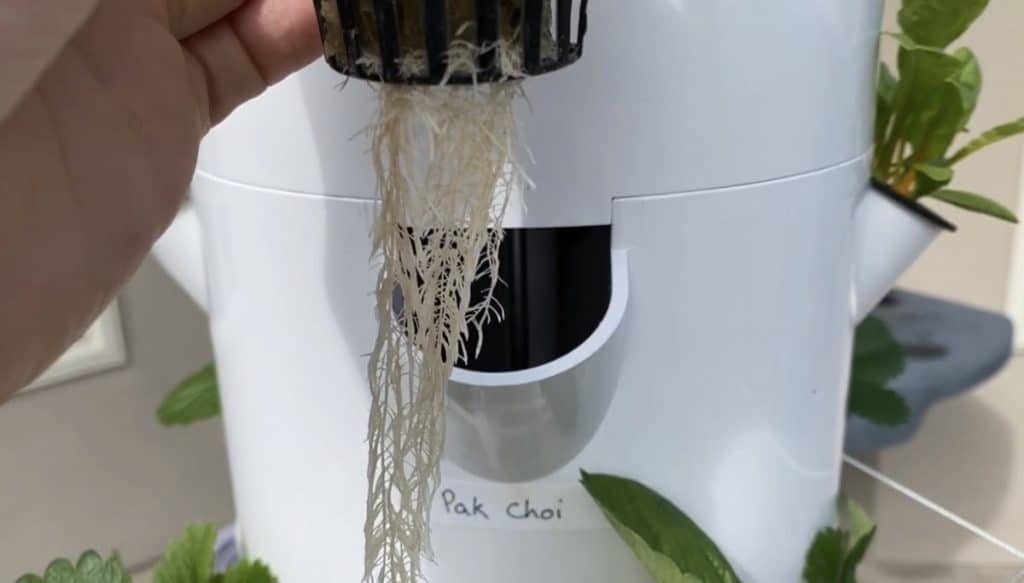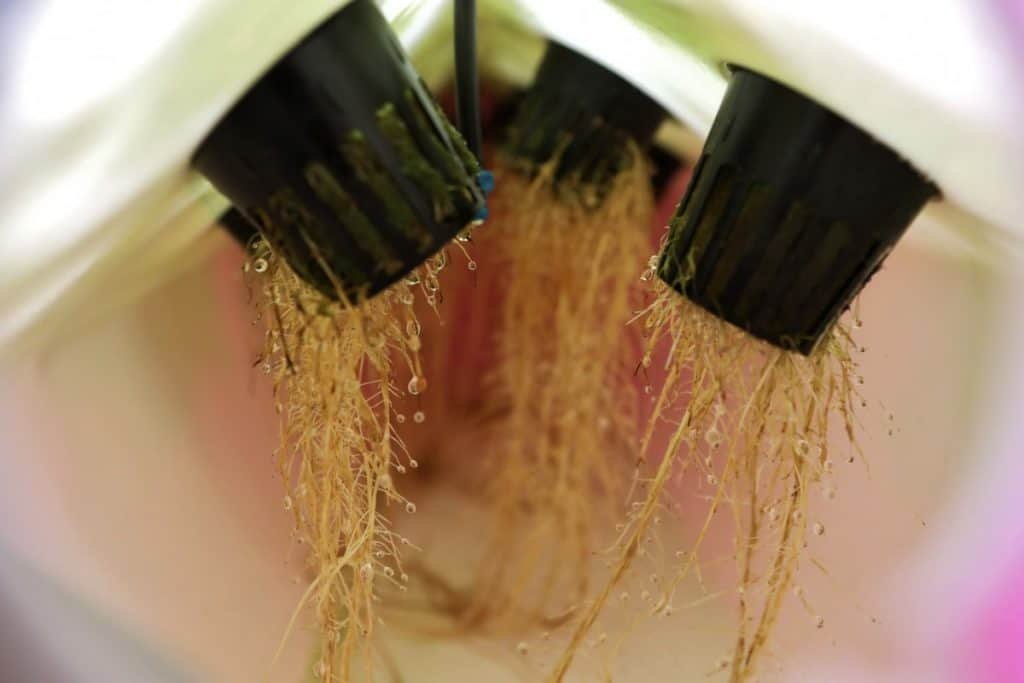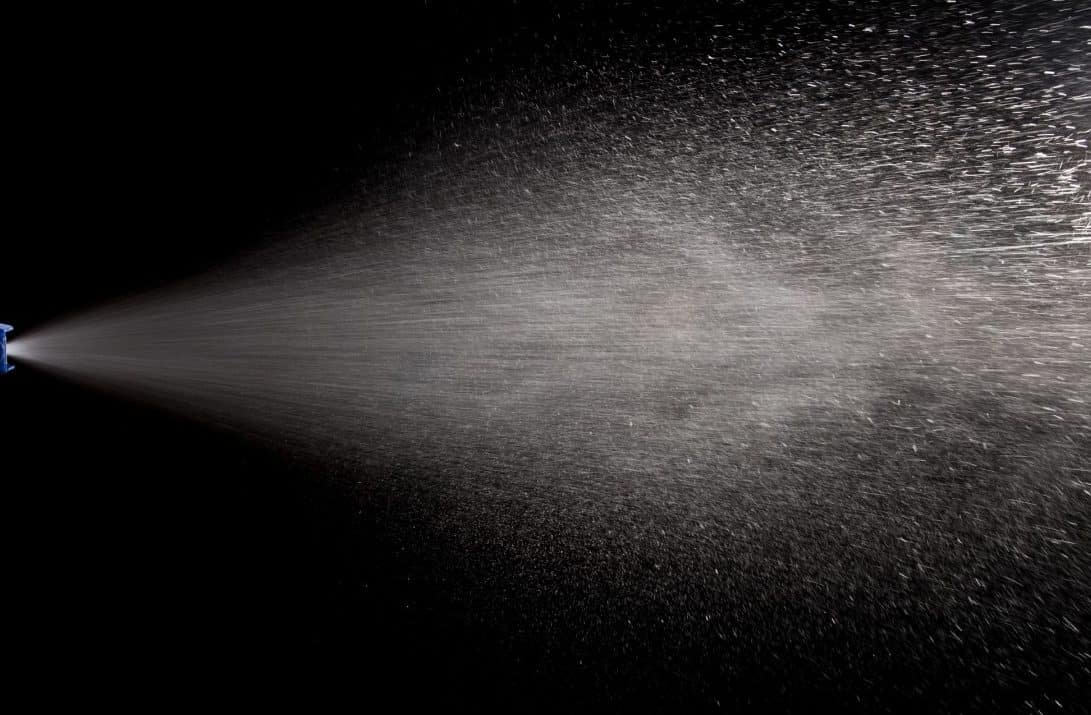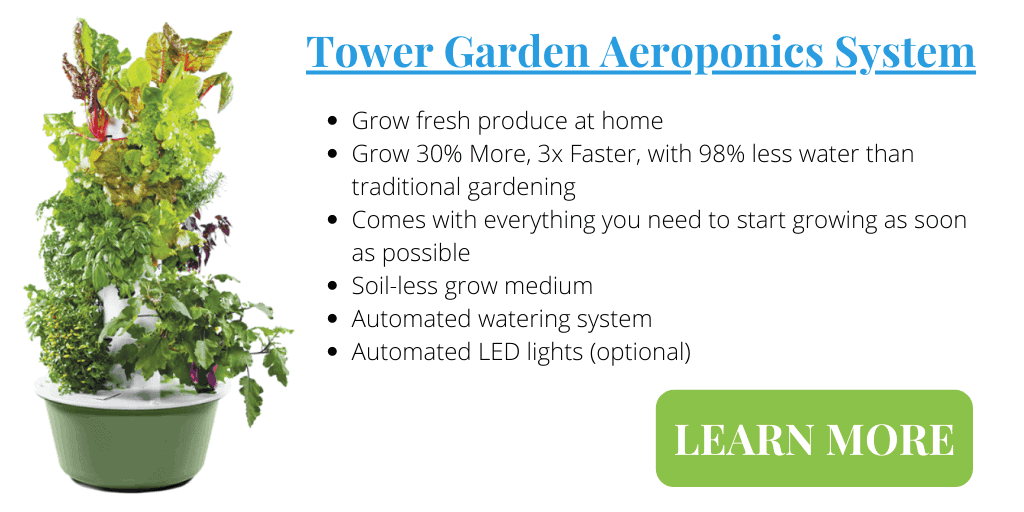Water delivery and humidity levels are arguably the most important factors of an aeroponic system. Because there is no soil and often no grow medium at all, the plant’s roots are very susceptible to drying out and dying if the watering system fails.
High pressure aeroponic system watering cycles typically operate on a 15 sec ON and 3 – 5 minute OFF cycle. This ensures the chamber maintains a high humidity level while preventing the fine mist from combining into larger droplets.
Low pressure systems use a 5 minute ON and 12 minute OFF cycle timer. A longer cycle is allowable with a low pressure system because it doesn’t rely on atomizing the water droplets. Instead the roots get deeply saturated with water before given a longer duration in oxygen to help them absorb the nutrients.
As a caveat, there are always outside variables that will determine the watering interval best suited to your style of system. Let’s dig into these variables in more detail to determine the proper watering cycle for different scenarios.
Factors Affecting Nutrient Absorption
To get the most efficiency out of your misting cycle, it’s important to understand the factors that affect a plant’s absorption abilities. Proper absorption of essential minerals is required for sustained and healthy plant growth.

Plant Root Structure
A healthy root structure has plenty of well established root hairs that increase the surface area of the root system. The increased surface allows more water and nutrients to coat the roots and gives the plant more ability to absorb the minerals it needs.
Root structure differs between plant species and those grown in aeroponics don’t need to develop an extensive system. This is because roots don’t need to search through soil, nutrients are delivered directly to the source.
Hairy and more branched roots will have a higher tendency to absorb water fast. Yet, this also means that they’ll dry up fast. The age of roots won’t affect the rate of mineral uptake as long as they’re in healthy conditions.
Temperature
Keeping the reservoir water temperature at a constant optimum range between 60 °F to 70 °F will maximize the absorption ability of the plant. Performing regular checks with the help of a thermometer is an easy way to ensure the water is at an ideal temperature.
When the water gets too warm, algae and bacteria are more likely to prosper in the system and negatively affect plant growth. This can be remedied by adding some ice to the reservoir to lower the temperature.
If the water drops below the 60 °F threshold adding some hot water from a kettle will increase the temperature back up to the ideal range. Another option for warming the water is using an aquarium heater with an adjustable thermostat. This will maintain the water temperature automatically but consume more power.

Droplet Size
Small droplets like the ones produced by a misting system are able to stick to the primary roots and root hairs without dripping off. This helps the water and nutrients remain readily available to be absorbed.
Larger droplets have more difficulty sticking to the roots due to their weight. They are more likely to drip off of the fine root hairs taking the nutrients with them back into the reservoir.
Oxygen Levels
Oxygen is the secret sauce of an aeroponic system, it acts as an accelerant for nutrient absorption. Maintaining a healthy oxygen supply to the roots allows them to absorb nutrients more easily.
Nutrient Balance
The best nutrients for aeroponic and hydroponic systems come in a 2 part mixture that gets blended directly into the reservoir.
These blends include Nitrogen, potassium, phosphorus, Calcium, Sulphur, Magnesium, Iron, Zinc, Boron and Manganese.
The purpose of keeping the two parts separate for storage is to prevent the minerals from binding with each other. Once the binding process occurs, the micronutrients become much larger and more difficult for the plants to absorb.
We always advised mixing each part into the reservoir separately rather than mixing them together before adding them into the water. For more information check out our article on The Best Nutrients for Aeroponics and Hydroponics.
One of the best aeroponic nutrient solutions on the market is Humboldts Secret Base A & B. It’s an easy to use 2 part mix that takes the mystery out of nutrient delivery. Used by all levels of aeroponic growers, this solution contains all the minerals required to bring your plants through explosive growth to huge yields.
- Fuel Plants With Complete Nutrition: Humboldts Secret Base A and B delivers a full-spectrum...
- Simplify Your Feeding Routine: Our easy two-part system requires no complex schedules or...
- Compatible With Any Grow Setup: Humboldts Secret nutrients are built for results in deep water...
The Time of the Day
Whether it’s day or night, plants will continue to take up nutrients from the mist. Since most plants are focused on the photosynthesis process by day, it’s noticeable that plants take up more nutrients at night.
That’s why many commercial and home growers tend to adjust the spraying interval according to the time of the day. Many growers adjust their pumps to water more frequently at night.
Watering of Indoor Systems vs. Outdoor Systems
The watering schedule of indoor aeroponic systems is usually a bit different from outdoor systems due mainly to the environmental conditions. Let’s have a quick overview of the difference between them.
Indoor Systems
Indoor systems are much easier to control in terms of weather conditions. This means that you can optimize the temperature and humidity levels to keep the roots damp for longer.
This allows you to have more time between the watering intervals. That’s why you might not need to water the plant as frequently as an outdoor one.
This makes indoor systems easier to operate and maintain. There are very few adjustments required as the environmental conditions remain consistent.
Outdoor Systems
On the other hand, outdoor systems are usually cheaper and give you more space to work with. However, when the temperature is hotter, the roots might dry up much quicker.
That’s why you always need to water an outdoor system more frequently depending on the weather conditions, which are much harder to control. Extreme heat can cause a higher rate of evaporation while colder weather will make your plants go dormant or even die.
Different Methods of Watering Aeroponic Systems
Here are some of the common misting methods that you can try.

Using Simple Interval Misting for Root Growth
The regular method for misting is one of the simplest methods to follow. In this way, you use a cycle timer that controls the on and off time in seconds and minutes. A cycle timer repeats the same routine over and over 24/7.
The key is maintaining a 90-100% humidity level in the root section of the system while also keeping the droplet size smaller than 100 microns. Many growers are successful spraying for 3 to 15 seconds every 1 to 5 minutes. The longer your spraying cycle lasts, the more time you should allow before the next one.
As long as it’s working for the plants, you can maintain these fixed watering intervals throughout the life of the plants.
Using Continual Misting
Continual misting is more commonly used for rooting clones or cuttings. Because the roots have not formed, having an off cycle for oxygen and nutrient uptake isn’t as important.
This method doesn’t work well for the regular growth and flowering phase. It allows the water droplets to combine and makes it more difficult to maintain water temperature as the constant cycling of the pump creates heat.
The continual misting method also has more issues with clogged misters due to the excessive mineral buildup constant spraying causes. The crop yield of the continual system is always characterized by being lesser in both quality and quantity.
Different Aeroponic Systems and Techniques
There are different types of aeroponic systems with various methods and techniques for watering the plant.
There’s an ongoing debate throughout the aeroponic community on whether anything other than a high pressure system is true aeroponics but we love experimentation with different techniques.
Low-Pressure Aeroponics (LPA) Systems
These systems are more affordable and cost-efficient in the short term. That’s why they’re more common with home growers and small scale backyard farmers.
Unlike high-pressure aeroponic systems, LPA systems can work with low-pressure pumps similar to those used in aquariums and water features.
A low pressure system doesn’t rely on atomizing the water droplets, instead, it uses a longer watering cycle to thoroughly wet the roots then allow the roots to uptake the nutrients. Depending on the system, a common cycle time would be 5 mins ON and 12 mins OFF.
LPA is a much more simple method that requires less maintenance and a lower mechanical skillset. You won’t have issues with clogging misters and there are no high pressure fittings to fail.
The Low Pressure Aeroponic system I’ve had incredible success with is the Tower Garden vertical aeroponics system. It comes with everything you need to get started growing delicious and nutritious home grown produce.
To read more on my success with this simple and effective vertical growing tower check out What is a Tower Garden and How Does it Work.

High-Pressure Aeroponics (HPA) Systems
High-pressure aeroponics uses powerful pumps to optimize the droplet sizes down to micron levels. While it’s more expensive, these systems are great for large scale production.
That’s why High-pressure systems are more commonly used for commercial purposes. The plant roots in these systems are usually much thinner and more branched than others due to the small mist droplet sizes.
While regular roots are a bit rigid and yellowish in color, these roots are characterized by being white with tiny fluffy root hairs. In fact, these are among the signs that the HPA system is in good health condition.
Fogponic Systems
This is the most recent technology used in aeroponics. Unlike all the previous systems, fogging systems don’t even use misters and pumps.
Instead, it uses ultrasonic technology, in which the water vibrates in ultra-high frequencies causing millions of micro explosions that make the water turn into fog. This fog has super small water droplets of 1 micron or even smaller!
How Long Should the Misting Phase Continue?
The perfect conditions of a misting cycle are the ones that will keep the root hairs as humid as possible. Ideally, this should be as much close to 100% humidity as possible.
However, you need to minimize the excess of water as much as possible. The roots shouldn’t be dripping after the misting phase, instead, the root only needs to be damp.
The barely damp state of the root promotes the maximum uptake of nutrients, which supports the growth of the roots. That’s why in aeroponic systems, you try to optimize the humidity of the roots to keep it not too dry or too moist at the same time.
Ideally, you need to keep the misting cycles within a range of about 5 to 10 seconds only, especially in a high-pressure aeroponic system.
If you spray the roots for a longer time, you’ll be defeating the purpose of creating super fine droplets. With too much moisture on the roots, the nutrient solution droplets will be able to recombine and form droplets larger than 30 to 100 microns again.
That’s why it’s important to experiment with the plants you’re growing. This way, you’ll be able to spray the roots just before the roots start to dry up again.
Wrap Up
There you have it. A complete guide with everything you need to know about aeroponics and how often to water them.
As you can see, most aeroponic systems are sprayed for about 5 to 10 seconds every 3 to 5 minutes. However, you need to try out different intervals on your system to see the one that works the best for you.

